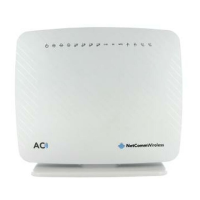NetComm Wireless NF17ACV User Guide
The individual fields shown above on the SIP Basic Settings page are explained in the following table.
Select the Interface that the VoIP account will use to make a connection to the VoIP Service Provider.
Set the SIP local port of the gateway, the default value is 5060. SIP local port is the SIP UA (user agent) port.
Enter the SIP domain name or IP address of your VoIP Service Provider here.
Select the checkbox of Use SIP Proxy, if your DSL router uses a SIP proxy. SIP proxy allows other parties to
call DSL router through it. When it is selected, the following fields appear.
The IP address of the proxy.
The port that this proxy is listening on. By default, the port value is 5060.
Some network service providers require the use of an outbound proxy. This is an additional proxy, through
which all outgoing calls are directed. In some cases, the outbound proxy is placed alongside the firewall and it
is the only way to let SIP traffic pass from the internal network to the Internet. When it is selected, the following
fields appear.
The IP address of the outbound proxy.
The port that the outbound proxy is listening on. By default, the port value is 5060.
Select this option if required by your VoIP Service Provider. Enter the SIP Proxy Domain Name and SIP Proxy
Port which is typically 5060.
The IP address of the SIP registrar.
The port that SIP registrar is listening on. By default, the port value is 5060.
If it is unselected, the corresponding account is disabled, you cannot use it to initiate or accept any call.
Enable or disable this function.
Set the user name of authentication.
Set the password of authentication.
User name. It is the Display Name.
Set the caller number. It must be a number of 0~9.
You can use it to set the packetization time (PT). The PT is the length of the digital voice segment that each
packet holds. The default is 20 millisecond packets. If selecting 10 millisecond, packets improve the voice
quality. Because of the packet loss, less information is lost, but more loads on the network traffic.
The priority of codec is declined from up to down. Codecs define the method of relaying voice data. Different
codecs have different characteristics, such as data compression and voice quality. For Example, G723 is a
codec that uses compression, therefore, it is good for use where the bandwidth is limited but its voice quality is
not good as other codecs, such as the G711. If you specify none of the codecs, using the default value
showed in the above figure, the DSL router chooses the codec automatically.
After entering your VoIP settings press the Apply button. Select Management > Save/Reboot and press the Reboot button. Once
the router restarts if there is a valid internet connection and the VoIP account settings are valid the VoIP service will start.

